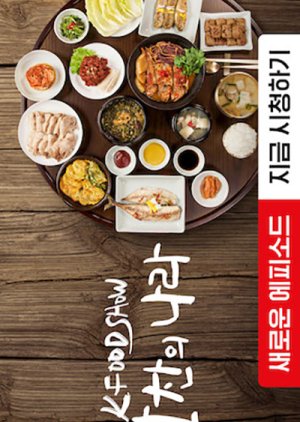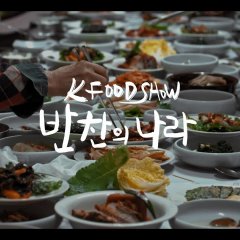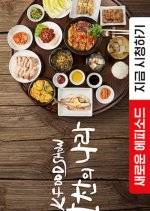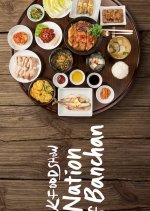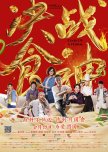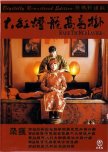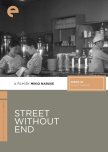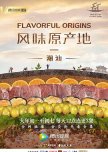- Português (Brasil)
- English
- Español
- 한국어
- Título original: K Food Show 반찬의 나라
- Também conhecido como:
- Gêneros: Comida, Documentário
Elenco e Créditos
- Heo Young Man Membro regular
- Ryu Soo Young Membro regular
- Mimi Membro regular
Resenhas

Esta resenha pode conter spoilers
A Nation of Banchan was an interesting look at Korea’s culture of rice and side dishes. Just like the greetings and farewells, “Did you eat?” and “Don’t skip meals” this special begins and ends with delicious meals. Heo Young Man, Ryu Soo Young, and Mimi travel across Korea eating at world class restaurants, restaurants run by ajummas, and places in between. Rice, fermented food, and seasonal ingredients are all explored.Banchan begins with the heart of the Korean meal---rice. The oldest rice seed was found on the Korean peninsula dating back between 13,000 and 17,000 years and the cultivation of it is still going strong. Approximately 3000 different rice brands are sold and instant rice has risen in popularity as well. They dine at a restaurant that specializes in serving rice in a variety of forms-chestnut porridge, alcohol, steamed, and noodles to name a few.
Side dishes are said to reflect the affection and generosity of the people. The cast travels to a restaurant run by women who have worked there for 20 years. The women bring in a sagging table that contains 24 side dishes. Then they brought in several more! The team barely made a dent in discovering different side dishes as Korea boasts more than 1500 types.
Next, they tackle wraps where anything edible is placed inside a leaf and eaten. Ssam dates back to Goryeo times. The leaf “embraces all ingredients.” They also tour where soy sauce is created and show a variety of jangs used to flavor foods.
The trio visits a Bibimbap restaurant next. Bibimbap is the food that shows “sharing and uniting the culture.” Whether using raw veggies or steamed, cooked meat or raw, it appears a practiced stir is needed.
Fermentation is investigated, the third style of food preparation---waiting. A food researcher is schooled by an old guru in how to make Jeotgal. At the fishing village the older woman demonstrates how fish and other seafood are salted and stored.
Episode 2-Seasonal Ingredients
“We can’t eat what’s grown in spring in summer…We can’t miss the time.”
Winter: Oysters are a winter staple and were cultivated in Korea going back 600 years. The trio goes to an oyster bar where they don protective gear to cook oysters on a grill at their table. They are also served oyster salad and pancakes.
Spring: In a country that is 70% mountainous, there is a long history of foraging for wild greens. They have lunch cooked by an older woman with nearly all of the ingredients either grown or found by her. Fried Acacia flowers, acorn jelly, and numerous wild green dishes are served with rice.
Summer: In a Bamboo forest, the three are treated to a feast cooked in a long bamboo tree called a “Steaming Dragon.”
Autumn: Rare pine mushrooms only found in the Fall for around 2 weeks are featured in an assortment of dishes at an upscale restaurant that Ryu goes to. Mimi is treated to seasonal raw fish at another high-end restaurant. Heo goes in the other direction to a small place that serves aged kimchi chicken stew. “Food that’s been aged a long time, like me, tastes better.”
I can’t say that all the dishes and styles of preparation made my mouth water, but I did enjoy how the meals were “built” and the history behind them. With the exception of a couple of places, it helps to be an omnivore as there were numerous meat dishes fermented or served. The three hosts were engaging and the two older ones informative. Mimi provided the wide-eyed wonder at discovering new flavors as a stand-in for the audience. Banchan means that a surprise guest isn’t a burden as there is always room for another at a table with plenty of side dishes. Korean meals are interpreted as a mother’s love, I think most mothers would approve of the love and dedication required to film this show about how seasonal ingredients and age-old methods are combined to nourish and strengthen those lucky enough to share a meal lovingly prepared.
11/1/23
Esta resenha foi útil para você?

It's more than banchan
A short 2-episode food show about banchans and more. I've always loved Korean food and after watching so many K-dramas, my love for it deepens and my tongue has grown stronger by eating all the spicy pork bulgogi from my favorite Korean restaurant.This short series provides us with a glimpse into the world of banchan (small side dishes served along with rice). I'm sure if you've been to a Korean restaurant, you will see these tiny dishes spread out on the table. This show introduced me to many different types of banchan and more. It also talks of the history of banchan, different cooking methods and using seasonal ingredients to make the best Korean dishes. Make sure you don't have an empty stomach when watching, as your tummy will growl and you will crave for some Korean food.
However, from a food tv show perspective, I have seen better storytelling and editing. The hosts are OK but they lack personality to hook you in. None of the 3 hosts (manhwa artist, actor, singer) is a food expert and that's OK. But their commentary and compliments are all the same and repetitive. When telling the history of the food, it sounds like they are reading from a script and have their lines memorized.
Nonetheless, I came for the food and to learn about the food. In that, I am satisfied.
A personal story - The first time I had bibimbap was many years ago when I was young and on a Korean Air plane. I had no idea what dish it was and how to eat it. So, I copied the passenger next to me, and bibimbap remains one of my favorite Korean dishes (especially if it's the stone pot version with the burnt rice at the bottom. YUM!)
Completed: 11/19/2023 - Review # 377
Esta resenha foi útil para você?
Recomendações
There have been no recommendations submitted. Be the first and add one.

